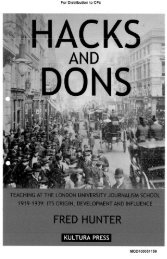The Edi ' - The Leveson Inquiry
The Edi ' - The Leveson Inquiry
The Edi ' - The Leveson Inquiry
You also want an ePaper? Increase the reach of your titles
YUMPU automatically turns print PDFs into web optimized ePapers that Google loves.
Gudt s~ 8ssoc~aUon<br />
For Distribution to CPs<br />
=[=his clause is designed to protect the innocent from being caught<br />
accused person to court or made public statements on the case, that<br />
|unnecessarily In the publicity spotlight focused on the guilty<br />
Relatives or friends should not normally be named unless they a~<br />
would add genu ne relevance.<br />
genuinely relevant to the story ~ or there is reason to publish in the Tone and proportion: However, the Commission would also take<br />
public interest, Child witnesses or victims of crime need special account of the tone of the article -- how much the storyfoccsed on<br />
consideration the relationship -- and whether that was relevant or in the public<br />
Complaints usually hinge on genuine relevance to the story or interest<br />
whether there is a pu blic interest in them being mentioned or whether A complaint from a councillor, named in a report when his son was<br />
identification is gratuitous, arrested for bootlegging was ’ re ected. ]-he PCC decided the simple <strong>The</strong> panel<br />
colour co~le<br />
<strong>The</strong> PCC has taken a cornmonsense line. If a relationship were factual identification of an rnportant community figure did not breach<br />
wel! known and established in the public domain, then it would be<br />
the Code. (@,~o~a ~o L:)aJy £x~re,’- s -epor~ 4J, 1997}<br />
~ Wha the<br />
Codesays<br />
perverse to expect editors to omit reference to it.<br />
Similarly if a parent, for example, publicly accompanied the<br />
L kew se<br />
’<br />
Mrs Ann G nag<br />
’<br />
wide y known as the owner of a<br />
Scottish castle, objected when she was named nstor es report ng<br />
her sondn-law’s arrest for allegedly assaulting her daughter, But the<br />
daughter lived at the castle -- and the accused husbano had been<br />
banned from it as part of the bail conditions<br />
<strong>The</strong> PCC said Mrs Gloag’s relevance to the story had been<br />
~’~ Ke<br />
~st~o%<br />
emmrs neen<br />
to ask<br />
themselves<br />
~vhen Code<br />
ssues anse<br />
established by her ownership of the castle named in the court<br />
~,~ Briefings<br />
on specific<br />
papers. Being related to the accused did not give her rights to<br />
anonymity that would otherwise not exst (G~ea~ f P~,~;hir~<br />
areaswnere<br />
the Code<br />
applies<br />
8<br />
But another case, where a front-page report named and pictured<br />
a councillor whose son was accused of a serious drink-driving<br />
offence, was upheld. While the PCC accepted there was a public<br />
interest in naming the councillor, because of her tocel prominence<br />
and the fact that she had attended court with her son, it ruled that no<br />
°s s %~ ~{T Rt;L NGS<br />
.=fetives or friends consent ~o identification? Consent might be<br />
impti~ ~d by being publicly invelved or pictured with the defendant. ~<br />
eD©~{ 4<br />
T:;;e;~ F~rt~s£ir~ ,~vs~:,~: ~:~ ~or ~5 ;;’;;b!<br />
Are t "ray genuinely relevant to the ~ery? Do they have a role, either in the ~ ei ,, ,~e%~boume A ~’~;~ qcw~ : sS/6(. :?f;{3~<br />
case or through a close involvement with the defendant? Could they be<br />
pars[ nelly Or professionally affected by the case or its outcome?<br />
is ~ ,nfion {n the public ktte~st? Is the relationship in the public domain,<br />
caul~ the case affect the public life of ~e relative or friend?<br />
Is th~ ~ f~cUs proportionate f~ the involvement Of relafiva or friend?<br />
Has ~uffi~ient care been faken te protect vu|nerabta children?<br />
public interest had been served by the story being focused so<br />
predominantly on her ece}, v t~as~bcu~.qe },as, erie- ;Zepo~7 "~"<br />
Protecting children’s welfare: <strong>The</strong> special protection g~ven to<br />
children in sub-clause 9ii is a continuation of the spirit of the Clause<br />
6 prows~ons and amounts to a duty of care aimed at preventing them<br />
from becoming further damaged, or their welfare affected, by their<br />
innocent involvement as w~tnesses or victims of crime.<br />
A tocel newspaper, which named a 12-year-old witness to an<br />
attempted kidnap, breeched the Code -- even though it believed the<br />
girl’s mother had authorised the disclosure. <strong>The</strong> mother said she had<br />
not realised that the reporter’s talephone call was an interwew or<br />
what would be published. <strong>The</strong> PCC ruled that the newspaper had<br />
not paid sufficient regard to the girl’s vulnerability. ~a~ v Fa,s~ourne<br />
/~rgus: ~spem 5~/60, 2002)<br />
Legal freedem: <strong>The</strong> Code is clear (gii) that this alone should not<br />
affect the right to report legal proceedings. However, m cases<br />
involving the identification of children or victims of sex crimes, the<br />
Code’s requirements may be stiffer than those in law. (See Clause<br />
6: Children and C!ause I f: Wc~ims of Sexual Assautg.<br />
Lx~ w,~w,e~torsco~e,er£,~ 71<br />
MOD100036646
















